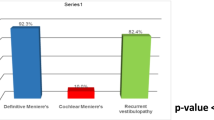Summary
An endolymphatic hydrops was induced in the left ear of each of 32 guinea pigs by obliteration of the endolymphatic sac. Both the hydropic ear and the control ear were examined by electrocochleography 1,2, 4 or 8 months after obliteration of the sac using electrodes on the apex and near the round window. One month after obliteration, the threshold of the compound action potential (AP) and the increase of the AP amplitude with sound pressure level (SPL) were the same as the results recorded from the control ears despite the presence of a histologically confirmed hydrops. In the 2-month group, small AP threshold differences (10–20 dB) were recorded, increasing up to 10–40 dB in the 4- and 8-month groups. In the latter animals we also found a more rapid increase of the AP amplitude with SPL, a finding suggestive of recruitment. In the 1-month group we recorded an enhanced negative SP for 2- and 4 kHz stimuli when the electrode was placed near the apex. The same was recorded for 4-kHz stimuli in the 2-month group. In the 4- and 8-month groups there was a tendency towards a decrease in the negative SP. The SP-AP ratio recorded from the apical position showed the same pattern as the SP amplitude, an increase after 1 month and a tendency to decrease in the following months. Near the round window there was no significant effect of hydrops on the SP amplitude or on the SP-AP ratio. A deviation in the AP-SP wave form was recorded in 69% (22/32) of the guinea pigs. This deviation most frequently consisted of an increased second peak (N2) in the AP wave form.
Similar content being viewed by others
References
Albers FJW, Veldman JE, Huizing EH (1987) Early hair cell loss in experimental hydrops. Ann Otol Rhinol Laryngol (in press)
Békésy G von (1952) Direct observation of the vibrations of the cochlear partition under a microscope. Acta Otolaryngol (Stockh) 42:197–201
Brookes GB, Hodge RA, Booth JB, Morrison AW (1982) The immediate effects of acetazolamide in Ménière's disease. J Laryngol Otol 96:57–72
Coats AC (1981) The summating potential and Ménière's disease. Arch Otolaryngol 107:199–208
Deelen GW van, Smoorenburg GF (1986) Electrocochleography for different electrode positions in guinea pig. Acta Otolaryngol (Stockh) 101:207–216
Durrant JD, Dallos P (1974) Modification of DIF summating potential components by stimulus biasing. J Acoust Soc Am 56:562–570
Eggermont JJ (1976) Electrophysiological study of the normal and pathological human cochlea. Rev Laryngol 97:497–506
Eggermont JJ (1976) Summating potentials in electrocochleography: relation to hearing disorders. In: Ruben RJ, Elberling C, Salomon G (eds) Electrocochleography. University Park Press, Baltimore, pp 67–87
Gibson WPR, Moffat DA, Ramsden RT (1977) Clinical electrocochleography in the diagnosis and management of Ménière's disease. Audiology 16:389–401
Gibson WPR, Prasher DK, Kilkenny GPG (1983) Diagnostic significance of transtympanic electrocochleography in Ménière's disease. Ann Otol Rhinol Laryngol 92:155–159
Hallpike CS, Cairns H (1938) Observations on the pathology of Ménière's syndrome. J Laryngol Otol 53:625–655
Kanzaki J, Ouchi T, Yokobori H, Ino T (1982) Electrocochleographic study of summating potentials in Ménière's disease. Audiology 21:409–424
Kimura RS (1967) Experimental blockage of the endolymphatic duct and sac and its effect on the inner ear of the guinea pig. A study on endolymphatic hydrops. Ann Otol Rhinol Laryngol 76:664–687
Kimura RS, Schuknecht HF (1965) Membranous hydrops in the inner ear of the guinea pig after obliteration of the endolymphatic sac. Pract Otorhinolaryngol 27:343–354
Kitahara M, Takeda T, Yazawa Y, Matsubara H (1981) Electrocochleography in the diagnosis of Ménière's disease. In: Vosteen KH, Schuknecht HF, Pfaltz CR, Wersall J, Kimura RS, Morgenstern C, Juhn SK (eds) Ménière's disease: pathogenesis, diagnosis and treatment. Thieme-Stratton, New York, pp 163–169
Klis JFL, Smoorenburg GF (1986) Modulation at the guinea pig round window of summating potentials and compound action potentials by low-frequency sound. Hear Res 20:15–23
Kumagami H, Miyazaki M (1983) Chronological changes of electrocochleogram in experimental endolymphatic hydrops. ORL 45:143–153
Kumagami H, Nishida H, Baba M (1982) Electrocochleographic study of Ménière's disease. Arch Otolaryngol 108:284–288
Martin GK, Shaw DWW, Dobie RA, Lonsbury-Martin BL (1983) Endolymphatic hydrops in the rabbit: auditory brainstem responses and cochlear morphology. Hear Res 13:65–87
Ruding PRJW, Veldman JE, van Deelen GW, Smoorenburg GF, Huizing EH (1987) Histopathologic study of experimentally induced endolymphatic hydrops with emphasis on Reissner's membrane. Arch Otorhinolaryngol 244:174–179
Schmidt PH (1976) Electrocochleographic diagnosis. Arch Otorhinolaryngol 212:315–320
Yamazaki T, Imoto T, Hayashi N, Watanabe S, Kozaki H, Abe T (1982) Ménièrsche Krankheit und Isosorbid. Arch Otorhinolaryngol 234:97–104
Author information
Authors and Affiliations
Rights and permissions
About this article
Cite this article
van Deelen, G.W., Ruding, P.R.J.W., Veldman, J.E. et al. Electrocochleographic study of experimentally induced endolymphatic hydrops. Arch Otorhinolaryngol 244, 167–173 (1987). https://doi.org/10.1007/BF00464262
Received:
Accepted:
Issue Date:
DOI: https://doi.org/10.1007/BF00464262




